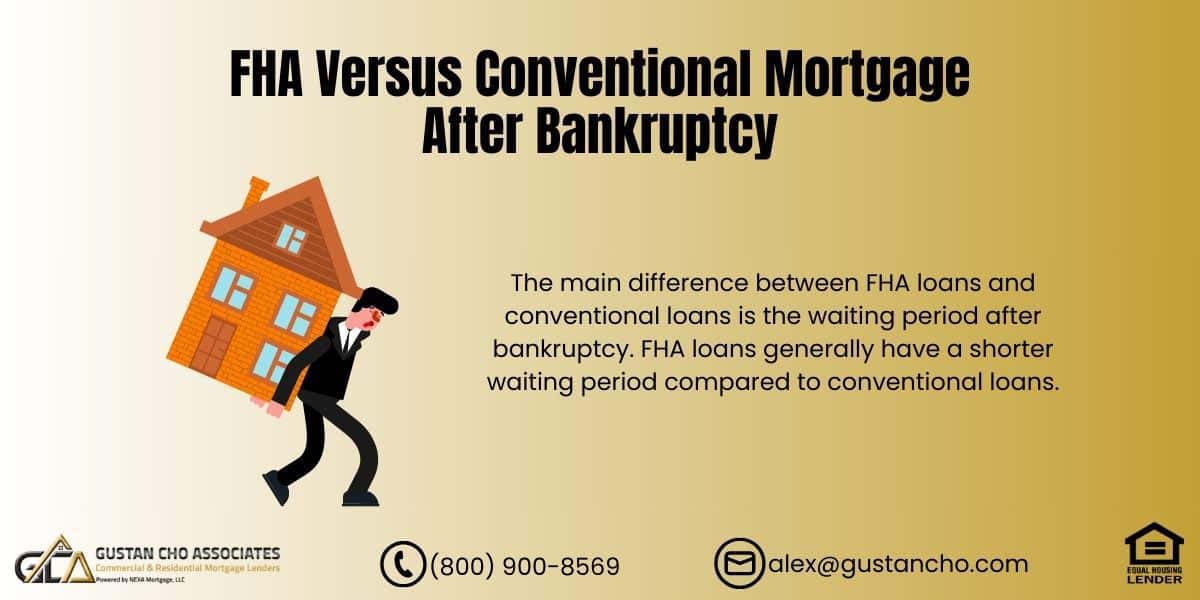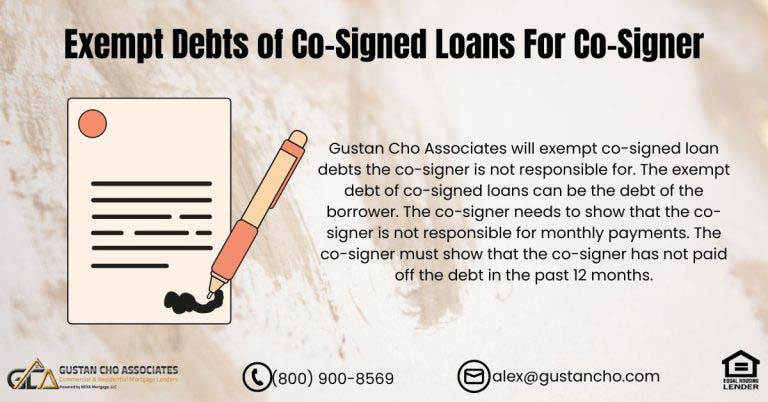This guide cover FHA versus conventional mortgage after bankruptcy. There are differences in when and how you can qualify for FHA versus conventional mortgage after bankruptcy. You can qualify earlier on FHA loans because the waiting period requirements on FHA versus Conventional mortgage after bankruptcy is shorter. The waiting period on FHA versus Conventional mortgage after bankruptcy is two years from the bankruptcy discharge date versus four years on conventional loans.
Consumers who filed Chapter 7 bankruptcy or are contemplating filing Chapter 7 can qualify for mortgage loans after bankruptcy after meeting waiting period requirements of the loan program.
The waiting period guidelines during and after Chapter 13 Bankruptcy repayment plan on FHA versus Conventional mortgage after bankruptcy is different too. In the following paragraphs, we will cover the differences of qualifying for FHA versus conventional mortgage after bankruptcy.
Waiting Period Guidelines on FHA Versus Conventional Mortgage After Bankruptcy
Consumers can get a fresh start after bankruptcy. Homebuyers can qualify for an FHA mortgage loan after 2 years after a Chapter 7 bankruptcy has been discharged. Federal guidelines require a mandatory 2-year waiting period for borrowers to wait after Chapter 7 Bankruptcy discharged date to qualify for FHA and VA loans.
USDA home loans requires 3 years. Home buyers can qualify for FHA and VA home loans one year into an active Chapter 13 Bankruptcy repayment plan with the approval of their Chapter 13 Bankruptcy trustee.
There is no waiting period to qualify for FHA and VA loans after Chapter 13 Bankruptcy discharged date. However, just passing the waiting period will not guarantee FHA mortgage loan approval. There are other factors such as re-established credit, minimum credit scores, no late payments after bankruptcy, and debt-to-income ratio requirements that borrowers must meet. Click Here to Apply For FHA Loan After Bankruptcy
Waiting Period Requirements on FHA Versus Conventional Mortgage After Foreclosure
There is a three year waiting period after the recorded date of foreclosure or deed-in-lieu of foreclosure to qualify for FHA and USDA loans. There is a three-year waiting period to qualify for FHA and USDA loans after a short sale. There is a two year waiting period after foreclosure, short sale, deed in lieu of foreclosure to qualify for VA loans.
Fannie Mae and Freddie Mac Guidelines on After Bankruptcy & Foreclosure
Fannie Mae and Freddie Mae are the two giant Government-Sponsored Enterprises that purchases the bulk of conforming loans on the secondary market. The Federal Housing Finance Agency (FHFA) is the regulatory federal agency that administers Fannie Mae and Freddie Mac Guidelines on conforming loans.
Conventional loans have longer waiting periods after bankruptcy and foreclosure than FHA loans. There are the mandatory waiting period after bankruptcy and foreclosure on conventional loans.
There is a four year waiting period after Chapter 7 Bankruptcy discharged date. There is a two-year waiting period after Chapter 13 Bankruptcy discharged datd. On a standard foreclosure, borrowers need to meet a seven-year waiting period after the recorded date of the foreclosure. Fannie Mae and Freddie Mac Guidelines mandate a four year waiting period after a short sale or a after the recorded date of deed-in-lieu of foreclosure.
What If I Had a Prior Mortgage Included in Chapter 7 on FHA Versus Conventional Mortgage After Bankruptcy
If a consumer had a mortgage or mortgages included in Chapter 7 Bankruptcy discharge, the waiting period after the Chapter 7 Bankruptcy is different on FHA versus Conventional mortgage after Bankruptcy. Fannie Mae and HUD differ on how they calculate the waiting period guidelines after the bankruptcy and housing event. There are many instances where home buyers may qualify for Conventional loans and NOT FHA, VA, USDA loans with a mortgage included in the bankruptcy and the deed is recorded at a much later date after the discharged date.
Fannie Mae Waiting Period on Conventional Loans With a Prior Mortgage Included in Bankruptcy
If a consumer has a prior mortgage included in the Chapter 7 Bankruptcy discharge, there is a three-year waiting period to qualify for FHA, VA, and USDA loans. The waiting period start date starts three years from the recorded date of the foreclosure, short sale, or deed-in-lieu of foreclosure.
The mandatory waiting period start date differs widely between government and conventional loans. The bankruptcy discharged date does not start the waiting period clock on government loans like it does on conventional loans.
With Conventional loans, there is a Four year waiting period from the discharged date of Chapter 7 Bankruptcy discharged date if the mortgage was included in the Chapter 7 Bankruptcy discharge. You cannot reaffirm the mortgage. The foreclosure can be recorded at a much later date than the discharged date of the Chapter 7 Bankruptcy and it does not matter. The foreclosure needs to be finalized and change hands from the homeowner to the lender or new owners.
VA Loans After Bankruptcy & Foreclosure
The Department of Veteran Affairs (VA) has much more lenient waiting period requirements after bankruptcy and foreclosure. There is a two-year waiting period to qualify for VA lafter Chapter 7 Bankruptcy discharged date. There is a two-year waiting period to qualify for VA loans after the recorded date of foreclosure or deed-in-lieu of foreclosure.
The actual date of the deed transfer from the homeowner’s name to the lender or sale date or sheriff’s sale is that waiting period start date on FHA loans.
There is a two-year waiting period to qualify for VA loans after the short sale. VA is the only mortgage loan program that exempts deferred student loans from debt-in-income ratio calculations with strong residual income. In order for deferred student loan DTI exemption, the veteran’s student loans need to be deferred 12 or more months. Click Here to Apply For VA Loan After Bankruptcy & Foreclosure
Lender Overlays on FHA Versus Conventional Mortgage After Bankruptcy
Most residential mortgage lenders have their own internal guidelines called overlays. Not all lenders have the same mortgage requirements. All lenders need to follow minimum mortgage guidelines but they can also set higher mortgage lending standards on top of the minimum mortgage guidelines. These higher mortgage standards are called lender overlays. Most lenders require three credit tradelines with at least one-year payment history. Lenders may require that credit tradelines be seasoned for 24 months. Many also require rental verification. Verification of Rent is only valid by providing 12 months on time canceled checks to the landlord.
Lenders can require a series of overlays for borrowers with prior Chapter 7 bankruptcy. Most lenders do not want to see any late payments by mortgage loan applicants after bankruptcy. They also want to see re-established credit.
Cash rental payments with a receipt by the landlord does not count. Verification of Rent is a strong credit requirement. The canceled check requirement can be waived if the property owner is a property management company or renting an apartment or home from a licensed property management company. Then the canceled check requirement is waived and a letter from the licensed property management company will be honored.
Mortgage Guidelines on Overdrafts After Bankruptcy
Lenders do not want to see any bank overdrafts in the prior 12 months. Bank statements with an overdraft in the past 12 months should not be turned in. Turn in 60 days of bank printouts in lieu of bank statements if the borrower has overdrafts. Get 2 months of bank statement print outs and have those print outs signed, stamped, and dated by the bank teller. Bank print outs do not reflect year to date overdraft fees and most mortgage loan underwriters will not question it.
Re-Establishing Credit After Bankruptcy
Consumers should start re-establishing credit as soon as possible after filing bankruptcy. The easiest and fastest way of re-establishing credit after bankruptcy is with 3 to 5 secured credit cards with $500 credit limits. Secured credit cards are a powerful tool in re-establishing credit and improving credit scores. Each secured credit should boost credit scores by 20 or more points. Many people can increase their credit scores by more than 100 points just with 3 secured credit cards after filing bankruptcy.
Credit Repair Program After Bankruptcy
Credit Disputes are not allowed during the mortgage process. Consumers can try to repair credit after filing bankruptcy on their own or by hiring a credit repair company. However, all credit disputes need to be retracted months before applying for a mortgage. Credit repair is the process of deleting derogatory information from a credit report . There are credit repair companies that can even remove bankruptcy from credit report.
The fact of the bankruptcy still remains on public records. It may improve credit scores and credit report might look cleaner, but mortgage applicants still need to disclose the bankruptcy on a mortgage application.
Lenders cannot find out about late payments, collections, and charge offs but public records such as bankruptcy, foreclosure, short sale, judgments, tax liens will get discovered. All lenders do a third party national public records search. Before starting a credit repair program, please consult with a mortgage loan officer.
Mortgage Guidelines on Credit Disputes
Credit disputes are not allowed in the mortgage application and approval process on FHA loans per HUD agency guidelines. Mortgage loan applicants need to stop disputing derogatory items six months prior to applying for a mortgage unless they have data and document proving the validity of the dispute.
Please note that the mortgage application and approval process will come to an abrupt halt and the file will be in suspense if the underwriter discovers unresolved credit disputes on the credit report on FHA loans.
Removing active credit disputes will lower credit scores. Pre-approvals should not be issued by loan officers on borrowers with credit disputes. Medical credit disputes are allowed and exempt. Non-Medical collections credit disputes with zero balances are exempt and does not have to be retracted. Borrowers who have disputes on collections with an aggregate total balance under $1,000, they do not have to retract those disputes.
Understanding Difference Between Credit Scores Versus Credit Report
There are minimum credit score requirements to qualify for FHA and Conventional loans. For example, FHA requires a minimum credit score of 580 for a 3.5% down payment home purchase loan. Conventional loans require 620 credit scores. However there just because borrowers meet minimum credit score requirements does not guarantee automatic credit approval. There is a difference between good credit scores and good credit payment history.
What Are The Automated Underwriting System Findings
The Automated Underwriting System will not just pick up on the qualifying credit score: But will scan and analyze the overall borrower’s credit report. Late payments in the past 12 months can potentially be disqualification of mortgage pre-approval. One or two late payments is not a deal killer but multiple late payments can get an AUS denial. Every consumer should be knowledgeable about credit, credit repair, and rebuilding and re-establishing credit. Contact us at Gustan Cho Associates for free credit information on credit, re-establishing credit, and how to improve credit to qualify for home loans. Click Here to Apply For FHA 203 Loan
Comparing Getting Approved For an FHA Versus Conventional Mortgage After Bankruptcy
Government-backed loans are normally easier to qualify and get approved versus conventional loans. Credit and income standards are substantially more lenient on government versus conventional loans. The best advise for borrowers is to contact a loan officer and go over each loan program and make a decision that yields the greatest net tangible benefit for you. Homebuyers who need to qualify for a government or conventional loan after bankruptcy or foreclosure with a lender with no lender overlays, please contact us at 800-900-8569 or text us for a faster response. Or email us at alex@gustancho.com. Eric Jeanette and the team at Gustan Cho Associates is available 7 days a week, evenings, weekends, and holidays.
- Related> Qualifying For a VA Loans During Chapter 13 Bankruptcy
- Related> HUD versus FNMA Guidelines on Mortgage After Bankruptcy
FAQs: FHA Versus Conventional Mortgage After Bankruptcy
- 1. What is the difference between an FHA versus conventional mortgage after bankruptcy? The main difference is the waiting period after bankruptcy. FHA loans generally have a shorter waiting period compared to conventional loans.
- 2. How soon can I qualify for an FHA versus conventional mortgage after bankruptcy? You can qualify for an FHA loan 2 years after a Chapter 7 bankruptcy discharge, while conventional loans require a 4-year waiting period.
- 3. Does the waiting period for FHA versus conventional mortgage after bankruptcy vary with the type of bankruptcy? Yes, FHA loans allow you to qualify 2 years after Chapter 7 discharge, but you may qualify during Chapter 13 with trustee approval. Conventional loans have a 4-year waiting period after Chapter 7 and a 2-year period after Chapter 13 discharge.
- 4. Can I get a mortgage during an active Chapter 13 bankruptcy? You may qualify for an FHA loan after one year in your Chapter 13 repayment plan, with approval from the trustee. With conventional loans, you must wait until after the discharge.
- 5. How does a prior foreclosure affect FHA versus conventional mortgage after bankruptcy? FHA loans have a 3-year waiting period after foreclosure, while conventional loans require a 7-year waiting period.
- 6. What if my mortgage was included in a Chapter 7 bankruptcy? The waiting period for FHA loans begins from the foreclosure date, not the bankruptcy discharge. Meanwhile, for conventional loans, the waiting period begins from the date of the bankruptcy discharge.
- 7. What are lender overlays on FHA versus conventional mortgage after bankruptcy? Lender overlays are additional requirements set by lenders on top of FHA or conventional guidelines. They can include stricter credit score requirements or longer waiting periods.
- 8. Is it easier to qualify for an FHA versus conventional mortgage after bankruptcy? Yes, FHA loans generally have more lenient requirements, making it easier to qualify compared to conventional loans.
- 9. How can I improve my chances of getting approved for an FHA versus conventional mortgage after bankruptcy? Re-establish credit by using secured credit cards, avoid late payments, and maintain a low debt-to-income ratio.
- 10. Should I consult a loan officer to decide between an FHA versus conventional mortgage after bankruptcy? Yes, it’s important to consult a loan officer who can help you determine which loan program is best based on your situation.










